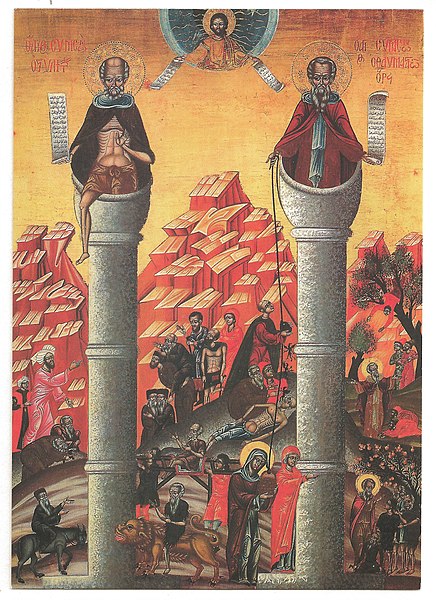A stylite or pillar-saint is a type of Christian ascetic who lives on pillars, preaching, fasting and praying. Stylites believe that the mortification of their bodies would help ensure the salvation of their souls. Stylites were common in the early days of the Byzantine Empire. The first known stylite was Simeon Stylites the Elder who climbed a pillar in Syria in 423 and remained there until his death 37 years later.
Icon of Simeon Stylites the Elder with Simeon Stylites the Younger. Simeon the Elder appears to be shown at the left stepping down from his pillar in obedience to the monastic elders; the image may also reference a point in his life when, due to an ulcerous leg, he was forced to stand atop his pillar on one leg only.[1] At right is represented Simeon Stylites the Younger (also known as 'St. Simeon of the Admirable Mountain').
This tower in Um er-Rasas, Jordan, has been interpreted as a stylite column.
Alfred, Lord Tennyson wrote an 1841 poem "St Simeon Stylites", illustrated here by W. E. F. Britten.
Simeon Stylites or Symeon the Stylite was a Syrian Christian ascetic, who achieved notability by living 37 years on a small platform on top of a pillar near Aleppo. Several other stylites later followed his model. Simeon is venerated as a saint by the Oriental Orthodox Churches, Eastern Orthodox Church, and Roman Catholic Church. He is known formally as Simeon Stylites the Elder to distinguish him from Simeon Stylites the Younger, Simeon Stylites III, and Symeon Stylites of Lesbos.
6th-century depiction of Simeon on his column. A scallop shell symbolizing spiritual purity blesses Simeon; the serpent represents demonic temptations (Louvre).
16th-century icon of Simeon Stylites. At the base of the pillar is his mother's body. (Historic Museum in Sanok, Poland)
Ruins of the Church of Saint Simeon with remains of his column (centre, now topped with a boulder)
A 1901 illustration by W. E. F. Britten for Alfred Tennyson's St. Simeon Stylites.






